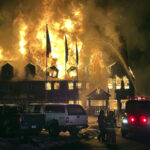The Ohio Insurance Institute (OII) reports that deer-vehicle crashes in the state decreased in 2014 by 2.5 percent over 2013. Nationally, however, claim costs from such collisions are up by more than 6 percent this year.
According to the Ohio Department of Natural Resources (ODNR), 19,705 deer-vehicle crashes were reported in 2014, compared with 20,201 crashes in 2013 and 20,999 in 2012.
Although such collisions are on the decline in the Buckeye state, there were four related fatalities and 798 injuries last year. This compares to eight fatalities and 968 injuries reported in 2013, and six deaths and 1,014 injuries in 2012.
The Insurance Institute for Highway Safety (IIHS) estimates about 200 fatalities are caused by deer-vehicle collisions each year in the United States.
The Highway Loss Data Institute (HLDI) examined crashes involving animals and found insurance claims peak in November, dropping off in December and January. The HLDI analysis shows that while fixing the damage to a car, pickup or SUV after an animal-strike can be costly, on average it’s not as costly as colliding with another vehicle.
Vehicle damage varies dramatically depending on the type of vehicle, its speed upon impact and area of the vehicle that sustains the hit. According to the State Farm, 2015 vehicle damage from deer collisions averages $4,135 per claim nationally — up 6 percent from the 2014 average of $3,888.
Some crashes involve multiple vehicles. Ohio Department of Public Safety (ODPS) reports 19,790 vehicles were involved in the 19,705 deer-vehicle crashes in 2014. The OII estimates deer-vehicle auto damages for 2014 at nearly $77 million, based on the average cost per claim ($3,888) and number of vehicles involved in crashes last year. OII auto damage estimates for 2013 were nearly $79.1 million.
Most insurers cover these losses under the “other than collision” (comprehensive) portion of an auto insurance policy, less the deductible. OII officials note that insurers normally don’t single out deer-vehicle collision losses in determining future premium adjustments. Such a collision alone should not affect future premiums.
Ohio’s five counties with the highest number of reported such crashes in 2014 were Stark (512), Richland (510), Lorain (510), Hamilton (433) and Clermont (482). Compared to their 2013 figures, Lorain and Clermont counties showed increases while the other three reported decreases in 2014.
Counties reporting the fewest crashes in 2014 included Monroe (12), Carroll (16), Morgan (20), Harrison (26) and Noble (37) counties. Of these, Monroe County showed an increase while the others experienced decreases in 2014.
According to Ward’s 2015 Motor Vehicle Facts & Figures, Ohio ranked among the top states in 2013 for the number of registered motor vehicles (6th), licensed drivers (7th) and annual miles driven (5th). These factors may affect the number of deer-vehicle crashes. ODPS reports nearly 11.5 million registered vehicles and almost 8 million licensed drivers share Ohio roadways.
Most deer-vehicle crashes occur at dusk and dawn, October–December, during deer-breeding season. In November 2014 there were 4,142 crashes on Ohio roadways — making it last year’s peak month for such collisions. According to data from the ODPS and ODNR, peak hours for these crashes were 5 p.m. to 1 a.m. followed by 5 a.m. to 8 a.m. In 2014, nearly 53 percent of these crashes occurred between 5 p.m. and 1 a.m., while 24 percent occurred early morning between 5 a.m. and 8 a.m.
Source: OII
Was this article valuable?
Here are more articles you may enjoy.


 State Farm Sued Over Policies Backed by Distressed Insurer PHL
State Farm Sued Over Policies Backed by Distressed Insurer PHL  What to Expect in 2026: US P/C Results More Like 2024
What to Expect in 2026: US P/C Results More Like 2024  OpenAI Warns New Models Pose ‘High’ Cybersecurity Risk
OpenAI Warns New Models Pose ‘High’ Cybersecurity Risk  Owner of Historic Minnesota Resort Charged With Arson, Insurance Fraud
Owner of Historic Minnesota Resort Charged With Arson, Insurance Fraud 

